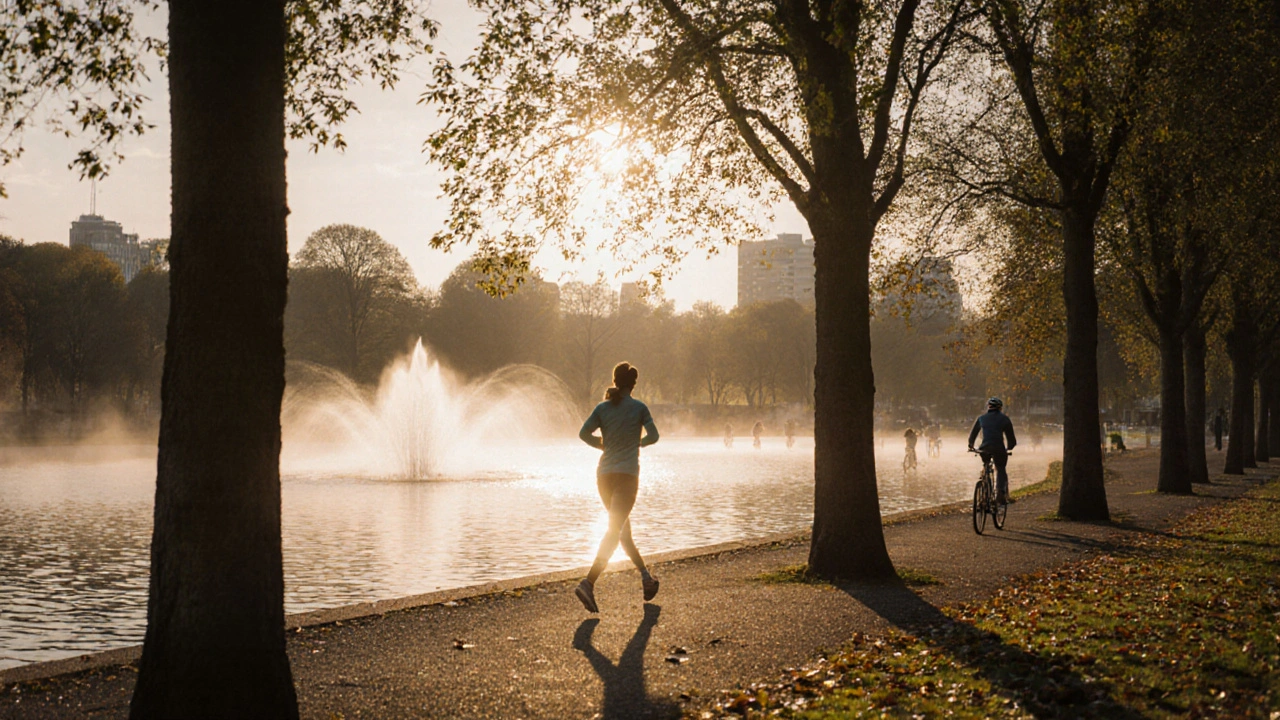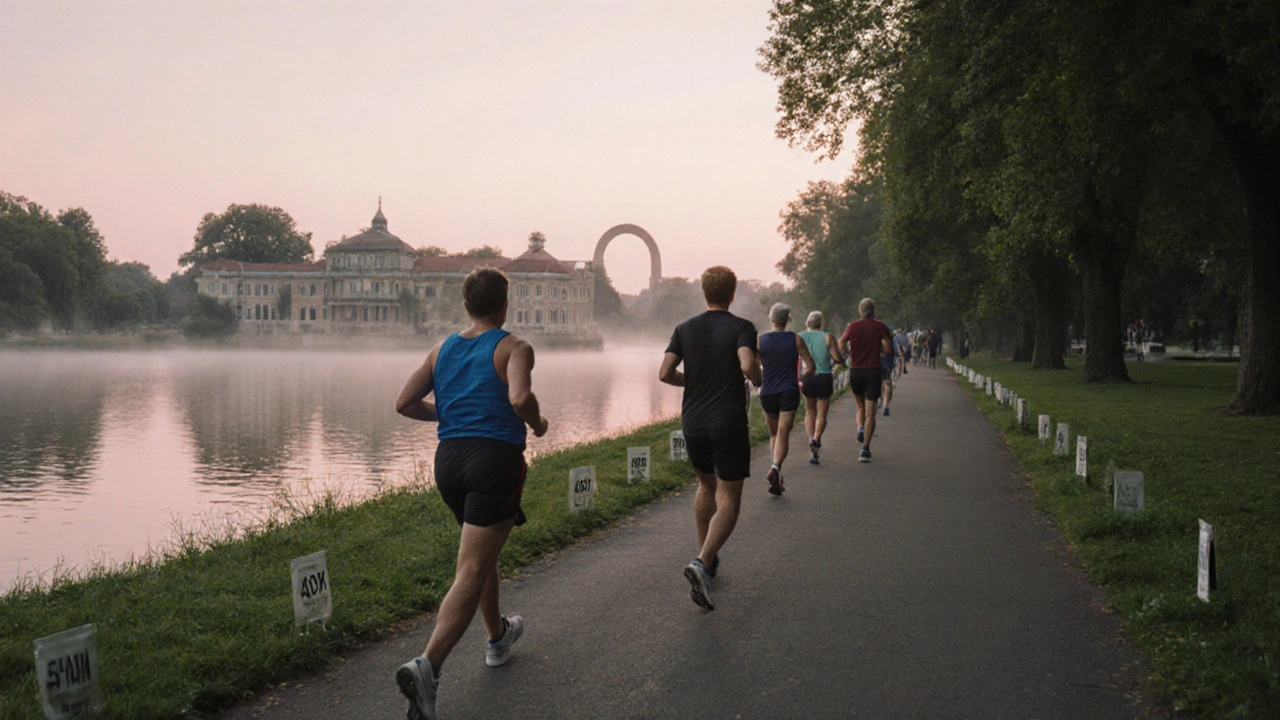Hyde Park: The Best Morning Jog in London

In London, where the morning fog still clings to the River Thames and the first buses rattle past Westminster, there’s one place that feels like it was made for runners: Hyde Park. It’s not just another green space in the city-it’s the heartbeat of London’s outdoor fitness culture. Whether you’re a commuter squeezing in a run before the office, a new expat looking for a way to explore, or a lifelong Londoner who’s tried every corner of the city, Hyde Park delivers something no other route can: space, history, and quiet momentum all in one.
Why Hyde Park Beats the Pavements of Central London
London’s streets are busy. The sidewalks near Oxford Circus get packed by 7:30 a.m. with people rushing to Tube stations, and the roads around Bank are thick with delivery vans and black cabs. Running there feels less like exercise and more like navigating a obstacle course. Hyde Park, by contrast, opens up like a breath of fresh air-literally. With over 350 acres of open land, wide gravel paths, and dedicated running lanes, it’s the only place in central London where you can actually pick up speed without dodging tourists with maps or cyclists swerving around pigeons.
Start at the Serpentine Lake’s eastern edge near Knightsbridge. The path here is smooth, flat, and lined with London plane trees that drop golden leaves in autumn. You’ll pass the Diana, Princess of Wales Memorial Fountain before you even hit your second mile. No traffic lights. No stop signs. Just you, the sound of your shoes on packed earth, and the occasional duck quacking as you pass the water’s edge.
The Classic 5K Loop That Londoners Swear By
The most popular route among regulars is the 5K loop around the Serpentine. It’s not just scenic-it’s measurable. The path is clearly marked with distance indicators every 400 meters, placed there by the Royal Parks charity. You’ll see runners in Nike Air Zooms, older men in Lululemon shorts, and young students in charity fundraiser vests from the London Marathon. Everyone’s here for the same reason: consistency.
Here’s how it works: Start at the Hyde Park Corner entrance near the Wellington Arch. Head north along the lake’s western shore, then cut across the grassy meadow near the Serpentine Boating House. Turn right at the bridge near the Italian Gardens, and follow the path back east. You’ll loop back to your start in under 30 minutes if you’re keeping a steady pace. Many runners time themselves here. Some even leave notes on the benches-‘Ran this loop 100 times. Still love it.’
What Makes Hyde Park Different From Other London Parks
Regent’s Park is nice, but it’s got narrow paths and more dog walkers than runners. St. James’s Park is beautiful, but it’s crowded with tourists posing for photos with pelicans. Richmond Park is wild and quiet, but it’s 30 minutes by Tube from central London-too far for a lunchtime jog.
Hyde Park sits right between Mayfair and Kensington, making it accessible from Paddington, Victoria, and Knightsbridge. You can run here after a late-night gig at the O2 Arena, before a meeting at the Shard, or on a Sunday after brunch at The Wolseley. It’s the only park in London that feels like it belongs to everyone-locals, tourists, athletes, retirees, and even the occasional jogger in a suit who just left a City meeting.
And then there’s the history. This was once the royal hunting ground of Henry VIII. Now, it’s where runners pass the same oak trees that witnessed the 1982 Hyde Park bombing, the 2012 Olympic marathon finish line, and the quiet dawn vigils after national tragedies. You don’t just run through a park-you run through layers of London’s soul.

Practical Tips for Running in Hyde Park
- Go early. The park opens at 5 a.m. in summer, 6 a.m. in winter. The best time to run is between 6:30 and 8 a.m., before the crowds and the dog walkers take over.
- Bring water. There are public drinking fountains near the Serpentine Café and the Diana Fountain, but they’re not always reliable. Most regulars carry a handheld bottle from brands like CamelBak or Hydro Flask.
- Watch for cyclists. The park has a dedicated cycle path along the south edge. Runners have right of way, but don’t assume cyclists will stop. A quick ‘on your left!’ goes a long way.
- Use the free Wi-Fi. If you’re tracking your run with Strava or Apple Fitness, the park has free public Wi-Fi at the Serpentine Café and near the Rose Garden. Your stats will upload even if your phone signal is weak.
- Don’t forget the weather. London rain can turn paths muddy. The Royal Parks team clears the main trails daily, but side paths near the Albert Memorial can get slick. Wear trail shoes if it’s been raining.
The Running Community You Didn’t Know Existed
There’s no official club, but there’s a culture. Every Tuesday at 7 a.m., a group of about 20 runners meets at the Hyde Park Corner entrance. They don’t call themselves a club-they just show up. Some are ex-marathoners. Others are recovering from injuries. One woman runs with her 80-year-old father in matching red jackets. You’ll see them at the café afterward, sipping tea from Fortnum & Mason mugs and talking about the weather, the news, or the latest London Marathon results.
There’s also the ‘Serpentine Sunday Long Run,’ where people gather for 10Ks and 15Ks. No registration. No fee. Just a shared coffee and a nod of encouragement. It’s the kind of thing you won’t find on Google Maps-but you’ll feel it the moment you join.

What to Do After Your Run
Hyde Park doesn’t end at the finish line. Just outside the Park Lane exit, you’ll find Yoga with Adriene pop-ups on weekends, or the London Running Company store where you can get your shoes fitted by a former Olympic trainer. If you’re hungry, head to Wagamama on the corner of Bayswater Road for a protein bowl, or Leon for a green smoothie and a banana loaf.
And if you’re feeling adventurous, walk 10 minutes to Kensington Palace. The gardens there are quieter, less crowded, and perfect for a slow cooldown with a view of the royal apartments.
Why This Isn’t Just a Jog-It’s a Ritual
London moves fast. The Tube is always late. The coffee is always too expensive. The weather is always uncertain. But in Hyde Park, at sunrise, everything slows down. You’re not just running. You’re breathing the same air as the poets who walked here in the 1800s, the soldiers who trained here in the 1940s, and the thousands of Londoners who come here every day to feel alive before the city wakes up.
It’s not the most glamorous route. There’s no neon sign. No Instagram filter. Just a path, a lake, and the quiet rhythm of your feet hitting the earth. And that’s exactly why it’s the best morning run in London.
Is Hyde Park safe for early morning runs?
Yes, Hyde Park is one of the safest green spaces in central London for early runs. It’s well-lit, patrolled by Royal Parks wardens, and constantly used by runners, walkers, and cyclists. The busiest times are between 6 a.m. and 9 a.m., so you’re rarely alone. Stick to the main paths and avoid the quieter wooded areas near the Rose Garden before sunrise if you’re uncomfortable.
Can I run in Hyde Park during winter?
Absolutely. Hyde Park stays open year-round. The main paths are cleared of snow and ice daily by the Royal Parks team. The lake may freeze over in cold snaps, but the running trails remain usable. Dress in layers-foggy mornings can drop to 2°C. A windproof jacket and thermal socks are essential. Many runners switch to trail shoes in December and January for better grip.
Are there bathrooms or water fountains along the route?
Yes. There are public toilets near the Serpentine Café, the Diana Fountain, and Hyde Park Corner. Water fountains are located at the same spots, plus near the Italian Gardens and the Park Lane entrance. They’re maintained by the Royal Parks, but they can occasionally be turned off for maintenance. Always carry a small water bottle as backup.
What’s the best time of year to run in Hyde Park?
Spring (April-June) and early autumn (September-October) are ideal. The weather is mild, the trees are full, and the crowds are manageable. Summer brings long daylight hours but more tourists. Winter is quiet but cold-perfect for focused runs if you’re prepared. Avoid July and August if you dislike heat and humidity.
Can I bring my dog on a run in Hyde Park?
Yes, dogs are allowed in Hyde Park, but they must be on a lead in the main running areas near the Serpentine and the memorial fountains. There’s a designated off-leash zone near the Albert Memorial and the western meadow, but it’s crowded on weekends. Many runners prefer to leave dogs at home during peak hours to avoid conflicts.